【Spring】AOP
AOP英文全称:Aspect Oriented Programming(面向切面编程、面向方面编程)。在程序运行期间在不修改源代码的基础上对已有方法进行增强(无侵入性: 解耦)
AOP快速入门
pom.xml
<dependency>
<groupId>org.springframework.boot</groupId>
<artifactId>spring-boot-starter-aop</artifactId>
</dependency>
AOP程序:TimeAspect
@Component
@Aspect //当前类为切面类
@Slf4j
public class TimeAspect {
@Around("execution(* com.itheima.service.*.*(..))")
public Object recordTime(ProceedingJoinPoint pjp) throws Throwable {
//记录方法执行开始时间
long begin = System.currentTimeMillis();
//执行原始方法
Object result = pjp.proceed();
//记录方法执行结束时间
long end = System.currentTimeMillis();
//计算方法执行耗时
log.info(pjp.getSignature()+"执行耗时: {}毫秒",end-begin);
return result;
}
}
AOP核心概念
连接点
JoinPoint,可以被AOP控制的方法(暗含方法执行时的相关信息),在SpringAOP提供的JoinPoint当中,封装了连接点方法在执行时的相关信息。
在Spring中用JoinPoint抽象了连接点,用它可以获得方法执行时的相关信息,如目标类名、方法名、方法参数等。
-
对于@Around通知,获取连接点信息只能使用ProceedingJoinPoint类型
-
对于其他四种通知,获取连接点信息只能使用JoinPoint,它是ProceedingJoinPoint的父类型
示例代码:
@Slf4j
@Component
@Aspect
public class MyAspect7 {
@Pointcut("@annotation(com.itheima.anno.MyLog)")
private void pt(){}
//前置通知
@Before("pt()")
public void before(JoinPoint joinPoint){
log.info(joinPoint.getSignature().getName() + " MyAspect7 -> before ...");
}
//后置通知
@Before("pt()")
public void after(JoinPoint joinPoint){
log.info(joinPoint.getSignature().getName() + " MyAspect7 -> after ...");
}
//环绕通知
@Around("pt()")
public Object around(ProceedingJoinPoint pjp) throws Throwable {
//获取目标类名
String name = pjp.getTarget().getClass().getName();
log.info("目标类名:{}",name);
//目标方法名
String methodName = pjp.getSignature().getName();
log.info("目标方法名:{}",methodName);
//获取方法执行时需要的参数
Object[] args = pjp.getArgs();
log.info("目标方法参数:{}", Arrays.toString(args));
//执行原始方法
Object returnValue = pjp.proceed();
return returnValue;
}
}
通知
Advice,指哪些重复的逻辑,也就是共性功能
通知类型
Spring中AOP的通知类型:
- @Around:环绕通知,此注解标注的通知方法在目标方法前、后都被执行
- @Before:前置通知,此注解标注的通知方法在目标方法前被执行
- @After :后置通知,此注解标注的通知方法在目标方法后被执行,无论是否有异常都会执行
- @AfterReturning : 返回后通知,此注解标注的通知方法在目标方法后被执行,有异常不会执行
- @AfterThrowing : 异常后通知,此注解标注的通知方法发生异常后执行
示例代码
@Slf4j
@Component
@Aspect
public class MyAspect1 {
//前置通知
@Before("execution(* com.itheima.service.*.*(..))")
public void before(JoinPoint joinPoint){
log.info("before ...");
}
//环绕通知
@Around("execution(* com.itheima.service.*.*(..))")
public Object around(ProceedingJoinPoint proceedingJoinPoint) throws Throwable {
log.info("around before ...");
//调用目标对象的原始方法执行
Object result = proceedingJoinPoint.proceed();
//原始方法如果执行时有异常,环绕通知中的后置代码不会在执行了
log.info("around after ...");
return result;
}
//后置通知
@After("execution(* com.itheima.service.*.*(..))")
public void after(JoinPoint joinPoint){
log.info("after ...");
}
//返回后通知(程序在正常执行的情况下,会执行的后置通知)
@AfterReturning("execution(* com.itheima.service.*.*(..))")
public void afterReturning(JoinPoint joinPoint){
log.info("afterReturning ...");
}
//异常通知(程序在出现异常的情况下,执行的后置通知)
@AfterThrowing("execution(* com.itheima.service.*.*(..))")
public void afterThrowing(JoinPoint joinPoint){
log.info("afterThrowing ...");
}
}
程序发生异常的情况下:
@AfterReturning标识的通知方法不会执行,@AfterThrowing标识的通知方法执行了
@Around环绕通知中原始方法调用时有异常,通知中的环绕后的代码逻辑也不会在执行了 (因为原始方法调用已经出异常了)
在使用通知时的注意事项:
- @Around环绕通知需要自己调用 ProceedingJoinPoint.proceed() 来让原始方法执行,其他通知不需要考虑目标方法执行
- @Around环绕通知方法的返回值,必须指定为Object,来接收原始方法的返回值,否则原始方法执行完毕,是获取不到返回值的。
Spring提供了@PointCut注解,该注解的作用是将公共的切入点表达式抽取出来,需要用到时引用该切入点表达式即可。
@Slf4j
@Component
@Aspect
public class MyAspect1 {
//切入点方法(公共的切入点表达式)
@Pointcut("execution(* com.itheima.service.*.*(..))")
private void pt(){
}
//前置通知(引用切入点)
@Before("pt()")
public void before(JoinPoint joinPoint){
log.info("before ...");
}
//环绕通知
@Around("pt()")
public Object around(ProceedingJoinPoint proceedingJoinPoint) throws Throwable {
log.info("around before ...");
//调用目标对象的原始方法执行
Object result = proceedingJoinPoint.proceed();
//原始方法在执行时:发生异常
//后续代码不在执行
log.info("around after ...");
return result;
}
}
通知顺序
- 不同的切面类当中,默认情况下通知的执行顺序是与切面类的类名字母排序是有关系的
- 可以在切面类上面加上@Order注解,来控制不同的切面类通知的执行顺序,前置通知:数字越小先执行; 后置通知:数字越小越后执行
切入点
PointCut,匹配连接点的条件,通知仅会在切入点方法执行时被应用
切入点表达式
- execution切入点表达式
- 根据我们所指定的方法的描述信息来匹配切入点方法,这种方式也是最为常用的一种方式
- 如果我们要匹配的切入点方法的方法名不规则,或者有一些比较特殊的需求,通过execution切入点表达式描述比较繁琐
- annotation 切入点表达式
- 基于注解的方式来匹配切入点方法。这种方式虽然多一步操作,我们需要自定义一个注解,但是相对来比较灵活。我们需要匹配哪个方法,就在方法上加上对应的注解就可以了
execution
execution主要根据方法的返回值、包名、类名、方法名、方法参数等信息来匹配,语法为:
execution(访问修饰符 返回值 包名.类名.方法名(方法参数) throws 异常)
-
访问修饰符:可省略(比如: public、protected)
-
包名.类名: 可省略
-
throws 异常:可省略(注意是方法上声明抛出的异常,不是实际抛出的异常)
可以使用通配符描述切入点
-
*:单个独立的任意符号,可以通配任意返回值、包名、类名、方法名、任意类型的一个参数,也可以通配包、类、方法名的一部分 -
..:多个连续的任意符号,可以通配任意层级的包,或任意类型、任意个数的参数
切入点表达式的语法规则:
- 方法的访问修饰符可以省略
- 返回值可以使用
*号代替(任意返回值类型) - 包名可以使用
*号代替,代表任意包(一层包使用一个*) - 使用
..配置包名,标识此包以及此包下的所有子包 - 类名可以使用
*号代替,标识任意类 - 方法名可以使用
*号代替,表示任意方法 - 可以使用
*配置参数,一个任意类型的参数 - 可以使用
..配置参数,任意个任意类型的参数
切入点表达式示例
-
省略方法的修饰符号
execution(void com.itheima.service.impl.DeptServiceImpl.delete(java.lang.Integer)) -
使用
*代替返回值类型execution(* com.itheima.service.impl.DeptServiceImpl.delete(java.lang.Integer)) -
使用
*代替包名(一层包使用一个*)execution(* com.itheima.*.*.DeptServiceImpl.delete(java.lang.Integer)) -
使用
..省略包名execution(* com..DeptServiceImpl.delete(java.lang.Integer)) -
使用
*代替类名execution(* com..*.delete(java.lang.Integer)) -
使用
*代替方法名execution(* com..*.*(java.lang.Integer)) -
使用
*代替参数execution(* com.itheima.service.impl.DeptServiceImpl.delete(*)) -
使用
..省略参数execution(* com..*.*(..))
注意事项:
-
根据业务需要,可以使用 且(&&)、或(||)、非(!) 来组合比较复杂的切入点表达式。
execution(* com.itheima.service.DeptService.list(..)) || execution(* com.itheima.service.DeptService.delete(..))
切入点表达式的书写建议:
- 所有业务方法名在命名时尽量规范,方便切入点表达式快速匹配。如:查询类方法都是 find 开头,更新类方法都是update开头
//匹配DeptServiceImpl类中以find开头的方法
execution(* com.itheima.service.impl.DeptServiceImpl.find*(..))
-
描述切入点方法通常基于接口描述,而不是直接描述实现类,增强拓展性
execution(* com.itheima.service.DeptService.*(..)) -
在满足业务需要的前提下,尽量缩小切入点的匹配范围。如:包名匹配尽量不使用 ..,使用 * 匹配单个包
execution(* com.itheima.*.*.DeptServiceImpl.find*(..))
@annotation
- 编写自定义注解
- 在业务类要做为连接点的方法上添加自定义注解
自定义注解:MyLog
@Target(ElementType.METHOD)
@Retention(RetentionPolicy.RUNTIME)
public @interface MyLog {
}
业务类:DeptServiceImpl
@Override
@MyLog //自定义注解(表示:当前方法属于目标方法)
public List<Dept> list() {
List<Dept> deptList = deptMapper.list();
//模拟异常
//int num = 10/0;
return deptList;
}
切面类
//前置通知
@Before("@annotation(com.itheima.anno.MyLog)")
public void before(){
log.info("MyAspect6 -> before ...");
}
切面
Aspect,描述通知与切入点的对应关系(通知+切入点)
切面所在的类,我们一般称为切面类(被@Aspect注解标识的类)
目标对象
Target,通知所应用的对象
Spring的AOP底层是基于动态代理技术来实现的,也就是说在程序运行的时候,会自动的基于动态代理技术为目标对象生成一个对应的代理对象。在代理对象当中就会对目标对象当中的原始方法进行功能的增强。
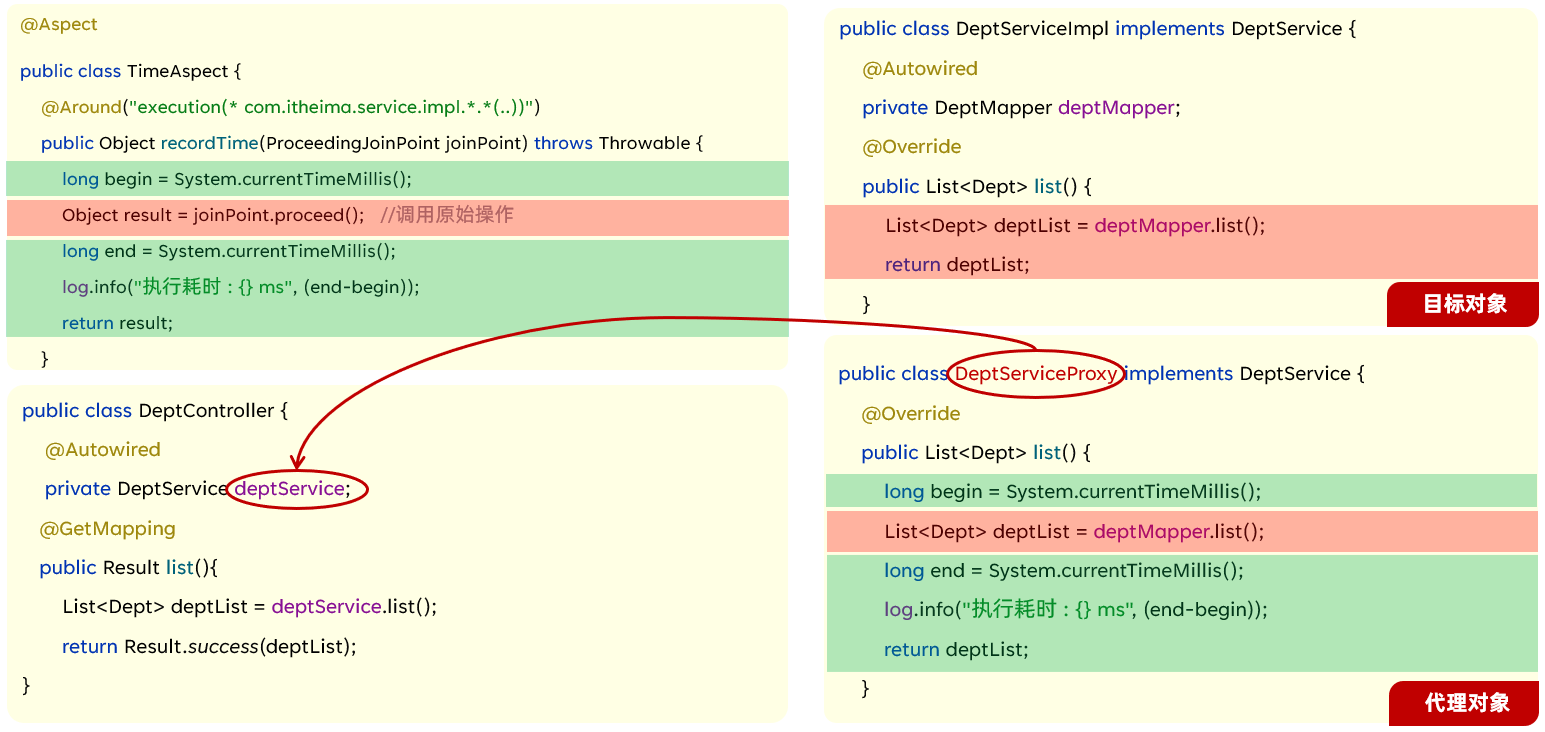

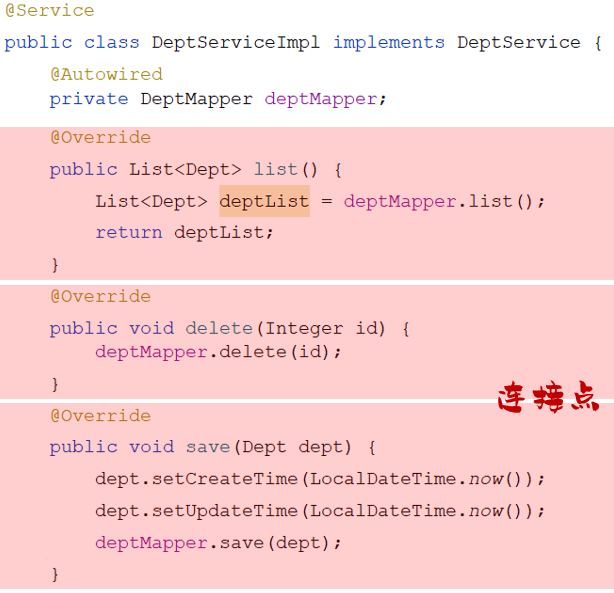
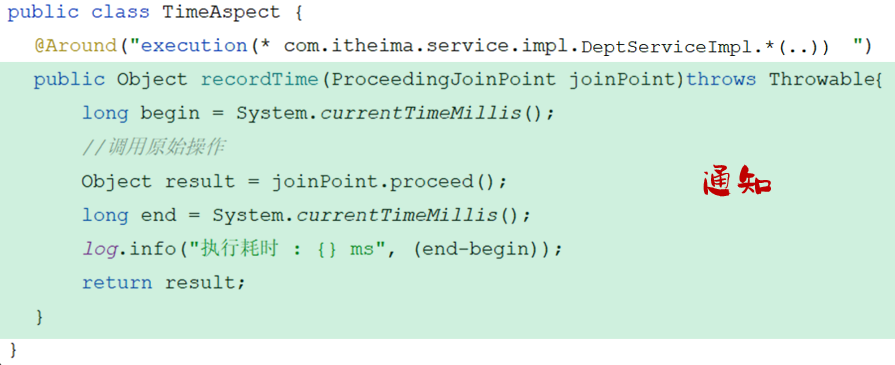
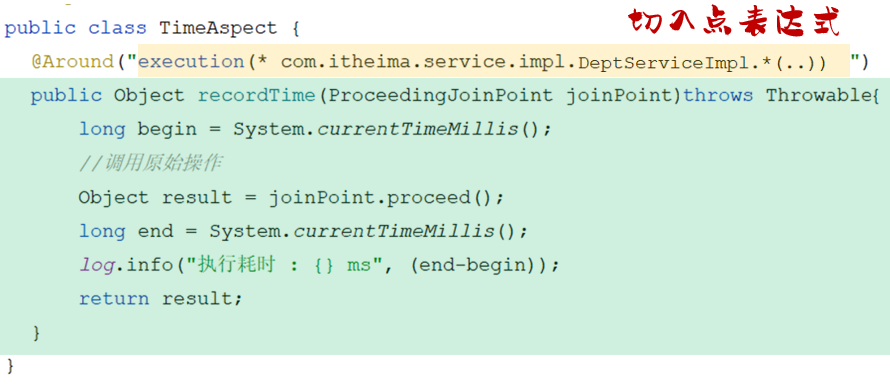
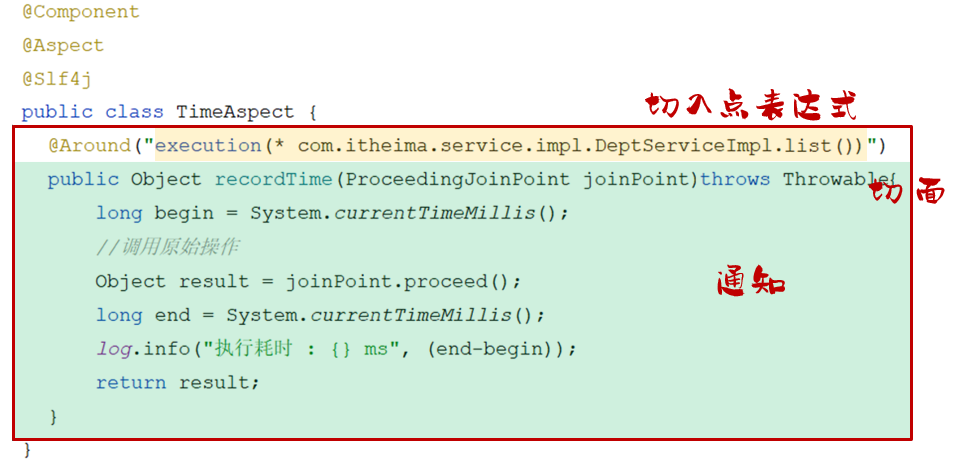



【推荐】国内首个AI IDE,深度理解中文开发场景,立即下载体验Trae
【推荐】编程新体验,更懂你的AI,立即体验豆包MarsCode编程助手
【推荐】抖音旗下AI助手豆包,你的智能百科全书,全免费不限次数
【推荐】轻量又高性能的 SSH 工具 IShell:AI 加持,快人一步
· 被坑几百块钱后,我竟然真的恢复了删除的微信聊天记录!
· 【自荐】一款简洁、开源的在线白板工具 Drawnix
· 没有Manus邀请码?试试免邀请码的MGX或者开源的OpenManus吧
· 园子的第一款AI主题卫衣上架——"HELLO! HOW CAN I ASSIST YOU TODAY
· 无需6万激活码!GitHub神秘组织3小时极速复刻Manus,手把手教你使用OpenManus搭建本